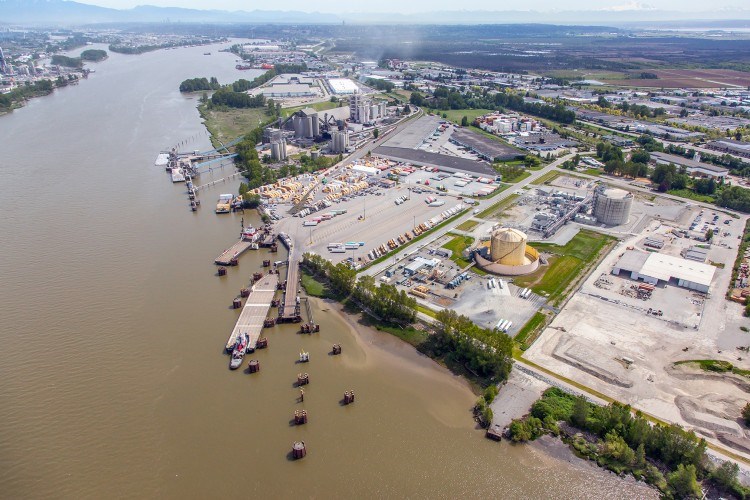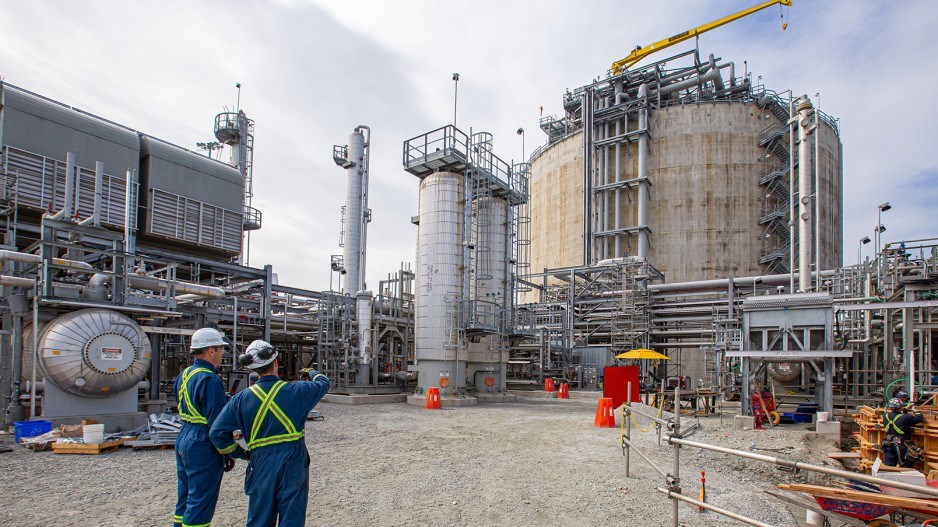鈥婳f the five liquefied natural gas projects in B.C. that are either under construction or in the environmental review process, two will need to pass a new provincial sniff test for greenhouse gas intensity.
One of them is FortisBC’s Tilbury Island LNG plant expansion in Delta, which is still working its way through the BC Environmental Assessment Office (EAO) review process. The other is the much larger Ksi Lisims project in Prince Rupert.
With a capital cost of $3 to $3.5 billion, the Tilbury Island expansion project is one of the largest capital projects on the major projects inventory for the Lower Mainland.
Should the project be approved, the expansion could bring the plant’s total production capacity up from 250,000 tonnes annually (current) to 3.4 million tonnes – a twelve-fold increase that would make it larger, in terms of production capacity, than the Woodfibre LNG project in 麻豆社国产(2.1 million tonnes) or Cedar LNG project in Kitimat (3 million tonnes).
The Tilbury Island LNG project is different from all others in B.C. in two respects. For one, it is an expansion of an existing LNG plant, not a greenfield project. Secondly, the LNG it would produce would not be solely, or even primarily, for export. Its main market would be domestic, including marine fuel bunkering and fueling trucks that run on compressed natural gas or LNG.
“The export piece is interesting, but it’s really not the core part of our story,” said Andrew Hamilton, FortisBC’s senior project manager for Tilbury Island. “There’s no firm contract for export. It’s an opportunity – we’re interested in it. But we are very, very closely watching the marine fuelling, the marine bunkering market, because that demand continues to grow.”
FortisBC has tested the export market by selling some LNG to China, via ISO container, through third party sellers. But due to a container shortage that resulted from a supply chain snarl during the global pandemic, there have been few sales in the last couple of years by ISO container, and FortisBC does not, as yet, have any long-term purchase agreements with customers in Asia.
“We may find that we build less than the 2.5 million tonnes because the market demand’s different, or there’s no export,” Hamilton said.
If an export market does develop for FortisBC, LNG would be exported by small LNG carriers that would dock at a proposed new marine jetty at the LNG plant site on Tilbury Island in Delta.

FortisBC’s LNG plant on Tilbury Island has been in operation since 1971 and already has natural gas pipeline connections. The Tilbury Island plant includes LNG storage tanks and regasification equipment. Originally, it’s sole purpose was to provide backup natural gas for peak demand periods or supply disruptions.
Between 2014 and 2019, FortisBC spent roughly $425 million to expand the plant to add additional production, mainly to serve a growing domestic market for natural gas as an alterative to diesel in the marine sector and in trucking. The phase 1 expansion brought its production up to 250,000 tonnes per year, but also includes a further expansion potential of another 650,000 tonnes.
FortisBC is now planning a second phase expansion, to the tune of $3 to $3.5 billion, which would add an additional storage tank (142,400 cubic metres) and an additional 2.5 million tonnes of annual production capacity. That would bring the plant's total potential production capacity to 3.4 million tonnes of LNG annually. The expansion would employ about 600 workers during peak construction.
As part of the plant expansion plans, FortisBC is also partner in a proposed new marine jetty, which would be used to fill LNG tankers for export and marine bunkering barges.
The Tilbury Island marine jetty is a joint venture – the Tilbury Limited Partnership – between FortisBC and Seaspan. The marine jetty proposal – estimated to cost $160 million to $200 million to build -- has already moved through the BC EAO process separately and now just awaits a final decision from provincial and federal Environment ministers.
The Tilbury Island phase 2 expansion is a bit further back in the EAO process. FortisBC plans to file an application this summer, which typically takes six months to review, Hamilton said.
Vancouver, Richmond and New Westminster city councils have registered their opposition to the expansion, citing concerns about greenhouse gases from upstream natural gas production, safety and impacts on air quality. More than a dozen First Nations are being consulted as part of the environmental review process for the phase 2 expansion.
Realistically, the earliest FortisBC could hope to get a green light for phase 2 is the end of 2024. With a construction phase of four to six years, the expanded plant would not likely be in production until between 2028 and 2030.
By then, it would need to be "net zero" in emissions, as per the provincial government’s new Energy Action Framework announced earlier this month. Essentially, the new framework would make it difficult for new LNG projects to be approved without committing to using electric drive, as opposed to natural gas drive.
In a recent analysis, Richard McCandless, a former B.C. civil servant who blogs about B.C. public policy issues, estimated that electrifying all five LNG projects in B.C., including second phase for the LNG Canada project, would require 18,500 gigawatt hours (GW/h) of electricity annually, whereas the new Site C dam will provide only 5,100 GW/h. He said it’s clear there will simply not be enough electricity in B.C. to power all these LNG projects.
“Either the new LNG projects are stillborn, or they use natural gas to condense the product (the practice of most LNG plants in the world) and compromise the government’s net zero emissions objective,” he recently wrote.
FortisBC’s Tilbury Island LNG plant has used electric drive from the beginning. Using it for the phase 2 expansion would produce 200,000 tonnes less CO2 annually than if natural gas drive were to be used, according to the company's project description.
Because it was designed to use e-drive, Hamilton said he believes FortisBC’s Tilbury Island expansion plan will fit with the provincial government’s new Energy Action Framework, which requires all new LNG projects to demonstrate they can be net zero by 2030.
“We’re proceeding under the assumption that all of that framework complies to the phase 2 assessment,” Hamilton said. "We're very comfortable that we will be able to work within that net zero by 2030 framework."
The phase 2 expansion would require 1,325 GW/h of electricity -- roughly one quarter of the annual generating capacity of Site C dam (5,100 GW/h).
Hamilton said FortisBC does not expect any problems in getting the electricity it will need.
“We do not believe we will be constrained by electricity,” he said. “Because we’ve been working with BC Hydro, we are comfortable that the electricity that we require for our development concept is available to us.”


